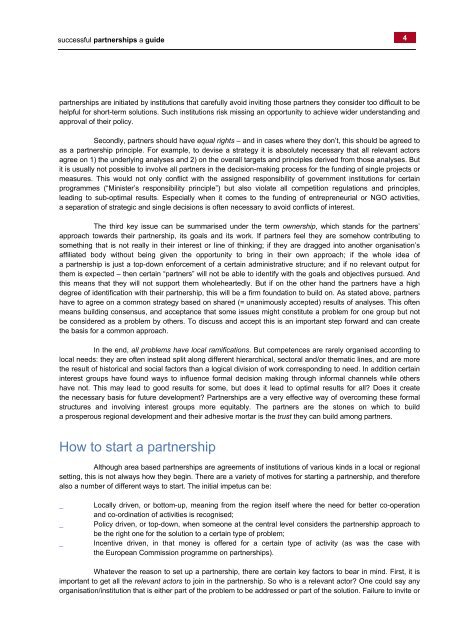successful partnerships a guide - Organisation for Economic Co ...
successful partnerships a guide - Organisation for Economic Co ...
successful partnerships a guide - Organisation for Economic Co ...
Create successful ePaper yourself
Turn your PDF publications into a flip-book with our unique Google optimized e-Paper software.
<strong>successful</strong> <strong>partnerships</strong> a <strong>guide</strong><br />
4<br />
<strong>partnerships</strong> are initiated by institutions that carefully avoid inviting those partners they consider too difficult to be<br />
helpful <strong>for</strong> short-term solutions. Such institutions risk missing an opportunity to achieve wider understanding and<br />
approval of their policy.<br />
Secondly, partners should have equal rights – and in cases where they don’t, this should be agreed to<br />
as a partnership principle. For example, to devise a strategy it is absolutely necessary that all relevant actors<br />
agree on 1) the underlying analyses and 2) on the overall targets and principles derived from those analyses. But<br />
it is usually not possible to involve all partners in the decision-making process <strong>for</strong> the funding of single projects or<br />
measures. This would not only conflict with the assigned responsibility of government institutions <strong>for</strong> certain<br />
programmes (“Minister’s responsibility principle”) but also violate all competition regulations and principles,<br />
leading to sub-optimal results. Especially when it comes to the funding of entrepreneurial or NGO activities,<br />
a separation of strategic and single decisions is often necessary to avoid conflicts of interest.<br />
The third key issue can be summarised under the term ownership, which stands <strong>for</strong> the partners’<br />
approach towards their partnership, its goals and its work. If partners feel they are somehow contributing to<br />
something that is not really in their interest or line of thinking; if they are dragged into another organisation’s<br />
affiliated body without being given the opportunity to bring in their own approach; if the whole idea of<br />
a partnership is just a top-down en<strong>for</strong>cement of a certain administrative structure; and if no relevant output <strong>for</strong><br />
them is expected – then certain “partners” will not be able to identify with the goals and objectives pursued. And<br />
this means that they will not support them wholeheartedly. But if on the other hand the partners have a high<br />
degree of identification with their partnership, this will be a firm foundation to build on. As stated above, partners<br />
have to agree on a common strategy based on shared (= unanimously accepted) results of analyses. This often<br />
means building consensus, and acceptance that some issues might constitute a problem <strong>for</strong> one group but not<br />
be considered as a problem by others. To discuss and accept this is an important step <strong>for</strong>ward and can create<br />
the basis <strong>for</strong> a common approach.<br />
In the end, all problems have local ramifications. But competences are rarely organised according to<br />
local needs: they are often instead split along different hierarchical, sectoral and/or thematic lines, and are more<br />
the result of historical and social factors than a logical division of work corresponding to need. In addition certain<br />
interest groups have found ways to influence <strong>for</strong>mal decision making through in<strong>for</strong>mal channels while others<br />
have not. This may lead to good results <strong>for</strong> some, but does it lead to optimal results <strong>for</strong> all Does it create<br />
the necessary basis <strong>for</strong> future development Partnerships are a very effective way of overcoming these <strong>for</strong>mal<br />
structures and involving interest groups more equitably. The partners are the stones on which to build<br />
a prosperous regional development and their adhesive mortar is the trust they can build among partners.<br />
How to start a partnership<br />
Although area based <strong>partnerships</strong> are agreements of institutions of various kinds in a local or regional<br />
setting, this is not always how they begin. There are a variety of motives <strong>for</strong> starting a partnership, and there<strong>for</strong>e<br />
also a number of different ways to start. The initial impetus can be:<br />
_<br />
_<br />
_<br />
Locally driven, or bottom-up, meaning from the region itself where the need <strong>for</strong> better co-operation<br />
and co-ordination of activities is recognised;<br />
Policy driven, or top-down, when someone at the central level considers the partnership approach to<br />
be the right one <strong>for</strong> the solution to a certain type of problem;<br />
Incentive driven, in that money is offered <strong>for</strong> a certain type of activity (as was the case with<br />
the European <strong>Co</strong>mmission programme on <strong>partnerships</strong>).<br />
Whatever the reason to set up a partnership, there are certain key factors to bear in mind. First, it is<br />
important to get all the relevant actors to join in the partnership. So who is a relevant actor One could say any<br />
organisation/institution that is either part of the problem to be addressed or part of the solution. Failure to invite or








